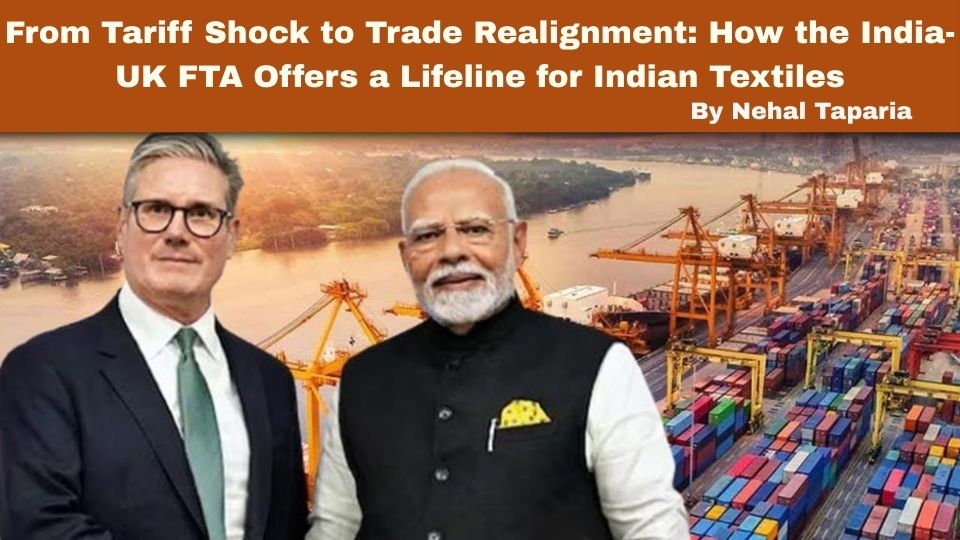From Tariff Shock to Trade Realignment: How the India-UK FTA Offers a Lifeline for Indian Textiles

From Tariff Shock to Trade Realignment: How the India-UK FTA Offers a Lifeline for Indian Textiles
1. A U.S. Tariff Tide: The Challenge Ahead
With the U.S. imposing steep 50% reciprocal tariffs on Indian goods—including textiles—exporters are staring down a major disruption. The U.S. has historically been India’s top textile export market, accounting for roughly 28–29% of exports through CY24 , . Anticipating lower competitiveness and margin erosion, exporters may see volumes drop significantly through CY26.
2. A Golden Thread: Leveraging the UK FTA
The recently concluded India-UK Free Trade Agreement FTA is emerging as a potential buffer. Under this FTA, Indian ready-made garments RMG and home textiles gain duty-free access to a nearly USD 23 billion UK import market, strengthening parity with regional competitors like Bangladesh and Vietnam.
3. Cushioning the Blow: Market Diversion in Action
According to a report by CareEdge Ratings, while India's textile export volume is projected to decline by 9–10% in CY26, the negative impact could be cushioned through realignment:
- Growth in cotton yarn and fabric exports.
- Accelerated access to the UK under FTA terms.
- Continued trade expansion into the EU as negotiations evolve.
4. Regional Growth Hubs Firing Up
States like Gujarat—which represent more than 12% of India’s textile exports—stand to benefit substantially. Tariff cuts of 8–16% on exports to the UK could potentially double shipments by 2026, revitalizing regional manufacturing clusters in Surat and Ahmedabad.
5. Growth Beyond Textiles
The UK FTA opens wide opportunities for:
- Garment sector—exports might double.
- Man-made fiber MMF value chain—including knitwear—set to expand rapidly with tailored investments .
- Long-term, overall trade volumes are expected to double in 5–6 years, especially in apparel and home textile categories .
6. Strategic Implications for the Indian Market
- Export Stability: The UK may absorb volumes lost from the U.S., mitigating immediate revenue hit.
- Supplier Realignment: Investment shifts toward MMF infrastructure and technical textiles.
- Job Creation & MSME Growth: Growth in textile hubs like Tiruppur and Ludhiana could generate new employment and scale MSMEs.
- Enhanced Policy Support: Expect ampler government assistance, export incentives, and global market outreach.
Bottom Line
While U.S. tariffs present a sizable shock, the India-UK FTA provides a strategic pivot—enabling textile exporters to rebuild revenue through alternative markets, invest in value chains, and innovate product lines. With focused local scaling, policy support, and global outreach, India’s textile sector can stitch a resilient and expansive post-tariff revival—and strengthen its positioning in the global textile trade.
By Nehal Taparia
This content is for educational and knowledge purposes only and should not be considered as investment or Trading advice. Please consult a certified financial advisor before making any investment or Trading decisions.
Our Recent FAQS
Frequently Asked Question &
Answers Here
Why are U.S. tariffs such a big deal?
The 50% tariffs, effective from 27 August, directly target India's biggest textile export market 28–29% share, threatening volumes and profitability.
Can the UK FTA really offset U.S. losses?
How much decline is expected in exports by CY26?
Which Indian regions benefit most?
What sectors derive broader gains from the FTA?
How fast could UK trade volumes rise?
What other support can help exporters?
Are MSMEs well-equipped to capitalize on this shift?
What’s the longer-term outlook?
Any hidden challenges?
Copyright © By Empirical F&M Academy. Design & Developed by Techno Duniya


.jpg)


.jpeg)




